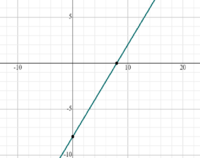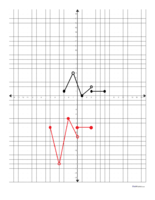The problem is this: draw the graph y=-2f(x-3)-5.
I've gone about this by doing the following:
1. I understand the graph of y=(x-3)-5 to be linear, and the table of values look like this:
x y
0 -8
1 -7
2 -6
3 -5
4 -4
5 -3

2. the -2f refers to a vertical compression, and based on what I've been able to find, the -2 is multiplied only by the Y values, so that the X values are left alone, and you reach the following values:
x y
0 16
1 14
2 12
3 10
4 8
5 6
Have I got this right?
I've gone about this by doing the following:
1. I understand the graph of y=(x-3)-5 to be linear, and the table of values look like this:
x y
0 -8
1 -7
2 -6
3 -5
4 -4
5 -3

2. the -2f refers to a vertical compression, and based on what I've been able to find, the -2 is multiplied only by the Y values, so that the X values are left alone, and you reach the following values:
x y
0 16
1 14
2 12
3 10
4 8
5 6
Have I got this right?


